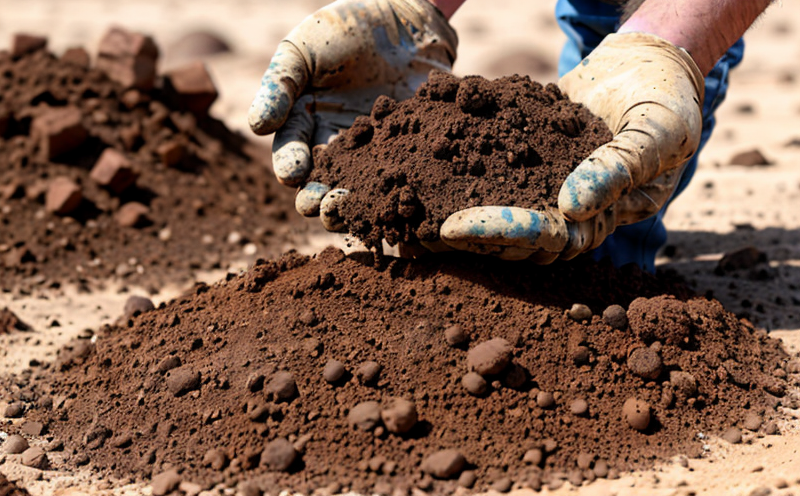ASTM D5856 Measurement of Hydraulic Conductivity in Porous Materials
The measurement of hydraulic conductivity using ASTM D5856 is a critical procedure used to evaluate the permeability and flow properties of porous materials such as soil, overburden, rock, and other geological formations. This test method is particularly important for mining operations where understanding the fluid flow through these materials can significantly impact project design, safety measures, and environmental considerations.
Hydraulic conductivity (K) is a measure of how easily water moves through a porous medium under hydraulic gradient. The higher the value of K, the more permeable the material is to water flow. This property is crucial in mining testing as it helps predict groundwater flow patterns, assess potential contamination pathways, and evaluate the stability of excavation sites.
The ASTM D5856 test method employs a laboratory setting where soil or overburden samples are saturated with water under controlled conditions. The hydraulic gradient is then established by applying a pressure difference across the sample. The rate at which water flows through the sample is measured, and from this data, the hydraulic conductivity is calculated using appropriate formulas.
This procedure is not only essential for mining operations but also beneficial in civil engineering projects involving soil stabilization, construction of dams, and other infrastructure developments. By accurately measuring hydraulic conductivity, engineers can make informed decisions about the suitability of materials for specific applications, ensuring both safety and efficiency.
The test method follows strict procedures outlined by ASTM to ensure accuracy and repeatability. It requires precise control over variables such as sample preparation, moisture content, temperature, and pressure gradient. The use of standard equipment and adherence to these guidelines ensures that results are comparable across different laboratories and projects.
Understanding the hydraulic conductivity of materials is vital for several reasons:
- To assess the risk of water intrusion into excavation sites
- To determine the effectiveness of barrier systems in preventing contaminant migration
- To optimize groundwater management strategies within mining operations
- To enhance the design and performance of drainage systems in engineered structures
The ASTM D5856 method is widely recognized for its reliability and consistency, making it a preferred choice among quality managers, compliance officers, R&D engineers, and procurement teams involved in mining projects. The accurate measurement of hydraulic conductivity ensures that decisions made based on these tests are scientifically sound and supported by empirical data.
By leveraging the expertise of our laboratory team, clients can benefit from comprehensive testing services tailored to their specific needs. Our state-of-the-art facilities and experienced staff provide reliable results that contribute to safer, more efficient mining operations.
Why It Matters
The measurement of hydraulic conductivity using ASTM D5856 is not just a technical exercise; it has significant implications for the safety, efficiency, and environmental impact of mining operations. Accurate hydraulic conductivity data helps in:
- Evaluating the risk of water intrusion into excavation sites
- Assessing the effectiveness of barrier systems in preventing contaminant migration
- Optimizing groundwater management strategies within mining operations
- Enhancing the design and performance of drainage systems in engineered structures
The importance of this test method cannot be overstated, as it directly influences critical decisions regarding project planning, resource allocation, and operational practices. By providing precise hydraulic conductivity values, our laboratory ensures that mining companies can make informed choices that balance economic goals with environmental responsibility.
In addition to these practical applications, the ASTM D5856 method also supports regulatory compliance and industry best practices. Compliance officers rely on accurate test results to ensure their operations meet all relevant standards and regulations. For R&D engineers, this method offers valuable insights into material behavior under different conditions, facilitating innovation and improvement in mining techniques.
The use of ASTM D5856 is essential for maintaining the integrity of mining projects while minimizing environmental impact. By understanding the hydraulic conductivity of materials, companies can implement effective mitigation strategies to protect ecosystems and communities near mining sites.
Benefits
The benefits of using ASTM D5856 in measuring hydraulic conductivity are manifold:
- Precise data: Provides accurate and reliable measurements that form the basis for informed decision-making.
- Regulatory compliance: Ensures adherence to international standards, supporting compliance with environmental regulations.
- Informed design: Allows engineers to make precise designs tailored to the specific properties of the materials being tested.
- Safety enhancement: Helps in identifying potential risks and implementing measures to mitigate them effectively.
- Economic efficiency: By ensuring that resources are used optimally, this test contributes to cost-effective project management.
- Environmental responsibility: Ensures that operations have minimal adverse impacts on the environment.
In conclusion, ASTM D5856 is a vital tool in the mining and construction sectors, offering invaluable insights into the behavior of porous materials under hydraulic conditions. Its application ensures safer, more efficient projects while promoting sustainable practices.
Quality and Reliability Assurance
Our laboratory takes pride in delivering high-quality results through rigorous quality assurance measures. We employ experienced technicians who are trained to follow ASTM D5856 procedures precisely. Our state-of-the-art facilities ensure that all tests meet the highest standards, providing reliable data that can be trusted.
We maintain strict adherence to ISO and ASTM guidelines, ensuring that our results are consistent with international best practices. This commitment to quality is reflected in our comprehensive reporting, which includes detailed descriptions of test procedures, observations, and conclusions. Our clients receive not only the numerical values but also a thorough analysis that helps them understand the implications of these measurements for their projects.
By choosing our laboratory for ASTM D5856 testing, you can be assured of accurate, reliable data that supports informed decision-making in your mining operations. Our expertise and commitment to excellence set us apart as a trusted partner for all your testing needs.





